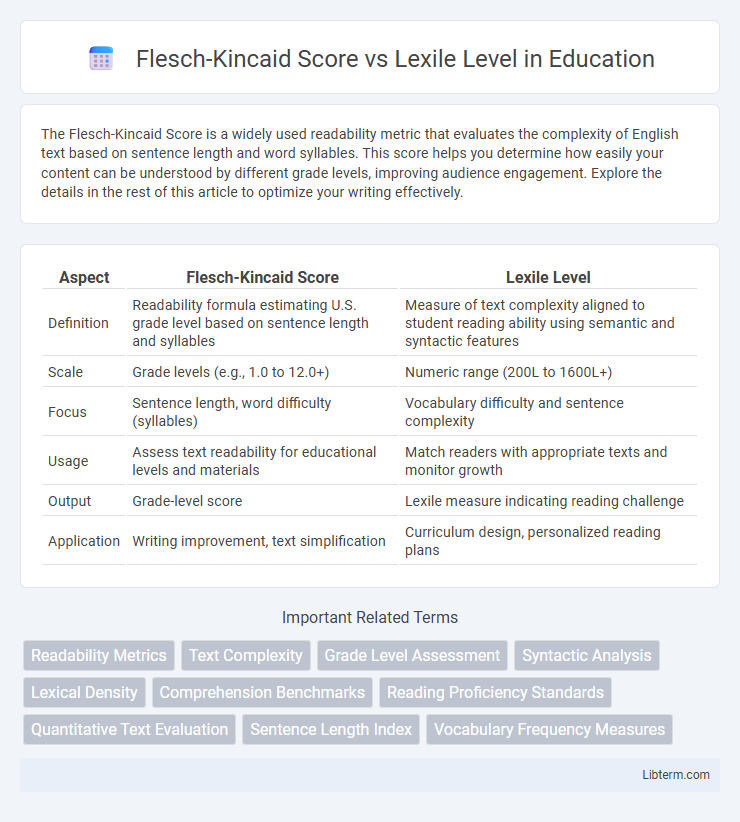The Flesch-Kincaid Score is a widely used readability metric that evaluates the complexity of English text based on sentence length and word syllables. This score helps you determine how easily your content can be understood by different grade levels, improving audience engagement. Explore the details in the rest of this article to optimize your writing effectively.
Table of Comparison
| Aspect | Flesch-Kincaid Score | Lexile Level |
|---|---|---|
| Definition | Readability formula estimating U.S. grade level based on sentence length and syllables | Measure of text complexity aligned to student reading ability using semantic and syntactic features |
| Scale | Grade levels (e.g., 1.0 to 12.0+) | Numeric range (200L to 1600L+) |
| Focus | Sentence length, word difficulty (syllables) | Vocabulary difficulty and sentence complexity |
| Usage | Assess text readability for educational levels and materials | Match readers with appropriate texts and monitor growth |
| Output | Grade-level score | Lexile measure indicating reading challenge |
| Application | Writing improvement, text simplification | Curriculum design, personalized reading plans |
Understanding Flesch-Kincaid Score
The Flesch-Kincaid Score measures text readability by calculating average sentence length and average syllables per word, providing a grade-level score that helps educators assess if material suits a reader's comprehension ability. Unlike the Lexile Level, which quantifies text complexity based on semantic and syntactic features and maps it to a numeric scale, the Flesch-Kincaid Score directly estimates reading difficulty through linguistic constructs. This score is widely used to tailor educational content and improve literacy by matching texts to appropriate reading proficiencies.
What Is the Lexile Level?
The Lexile Level measures text complexity by evaluating semantic difficulty and syntactic structure to match readers with appropriately challenging materials. Unlike the Flesch-Kincaid Score, which focuses primarily on sentence length and word syllables, the Lexile framework incorporates a comprehensive analysis of vocabulary frequency and sentence length. Educational professionals use Lexile Levels to guide reading development and tailor instruction based on individual student reading abilities.
Key Differences Between Flesch-Kincaid and Lexile
Flesch-Kincaid Score measures text readability based on word and sentence length, providing a grade-level interpretation primarily used for evaluating general reading ease. Lexile Level quantifies text complexity by analyzing semantic difficulty and syntactic structure, offering a numeric scale that aligns with student reading ability and text demand. The key difference lies in Flesch-Kincaid's focus on surface-level text features versus Lexile's integration of deeper linguistic factors for matching readers with appropriate materials.
How Both Metrics Measure Text Complexity
The Flesch-Kincaid Score evaluates text complexity by analyzing sentence length and word syllable count, providing a grade-level estimate that reflects readability for specific educational stages. In contrast, the Lexile Level combines semantic difficulty and syntactic complexity, using a proprietary algorithm to assign a numerical score indicating text difficulty and reader ability alignment. Both metrics serve educators by quantifying readability but differ in methodological focus, with Flesch-Kincaid emphasizing structural elements and Lexile integrating vocabulary and conceptual density.
Calculation Methods: Flesch-Kincaid vs Lexile
Flesch-Kincaid Score calculates readability by analyzing sentence length and syllable count per word, producing a grade-level score that estimates text complexity. Lexile Level uses a proprietary algorithm based on semantic difficulty and syntactic complexity, incorporating word frequency and sentence length to assign a numerical measure aligned with student reading ability. Both metrics provide quantifiable insights for matching texts to readers but differ in linguistic factors and the granularity of measurement.
Applications in Education and Publishing
Flesch-Kincaid Score and Lexile Level serve distinct yet complementary roles in education and publishing by measuring text complexity to match reader abilities. The Flesch-Kincaid Score relies on sentence length and syllable count to assess readability, often guiding educators in selecting appropriate grade-level materials. Lexile Levels integrate both text complexity and student reading ability, providing publishers and schools with tailored resources that support differentiated instruction and targeted literacy development.
Advantages of Using Flesch-Kincaid Scores
Flesch-Kincaid scores provide an easily interpretable measure of text readability by calculating sentence length and syllable count, making it highly accessible for educators and writers. It offers quick, objective assessments without requiring specialized software, facilitating immediate adjustments to match audience reading levels. The score's widespread use in educational settings supports consistent communication about text complexity across different materials and grade levels.
Benefits of Lexile Levels for Readers
Lexile Levels provide precise measurement of a text's complexity by analyzing semantic and syntactic features, offering tailored reading materials that match individual reader abilities. This targeted approach enhances comprehension and fosters growth by presenting challenges appropriate to the reader's skill level. Unlike the Flesch-Kincaid Score, which primarily assesses sentence length and word difficulty, Lexile Levels support personalized learning paths and data-driven literacy strategies.
Limitations and Criticisms of Both Systems
The Flesch-Kincaid Score often faces criticism for relying heavily on sentence length and syllable count, which can oversimplify text complexity and overlook contextual understanding. Lexile Levels are limited by their dependence on word frequency and sentence length, failing to account for nuanced content, text structure, and reader motivation. Both systems struggle to accurately measure reading comprehension and engagement, highlighting the need for more comprehensive assessment tools.
Choosing the Right Readability Metric
Choosing the right readability metric depends on the purpose and audience of the text; the Flesch-Kincaid Score primarily assesses sentence length and syllables to determine grade-level readability, ideal for general prose and educational materials. Lexile Level incorporates semantic and syntactic complexity alongside word frequency, offering a nuanced measure suited for matching readers to texts based on ability and content difficulty. Selecting between these metrics requires balancing simplicity and precision to enhance comprehension and engagement effectively.
Flesch-Kincaid Score Infographic

 libterm.com
libterm.com